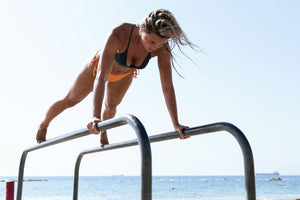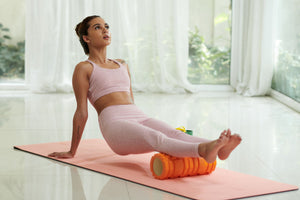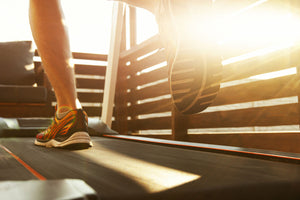The squat is a foundational functional movement pattern of the human.
It’s also an exercise that has built many of the greatest physiques known to mankind.
Still, many individuals avoid the movement due to outdated fitness myths implying that squats are bad for the knees or squats will make you bulky.
Trust us, if you want to get the best results possible from your training program, you want to squat, and squat often.
Today, we give you SEVEN different types of squats you can use in your workouts to keep you mentally motivated and physically challenged.
Before we get to the various types of squats, let’s quickly recap the muscles worked during the squat.
What Muscle Groups Work During Squats?
Squats activate an incredibly large amount of muscle in the body -- particularly the muscle groups in your thighs (quads and hamstrings), hips, and glutes.
They provide a tremendous muscle-building “bang” for your exercise effort “buck.”
The traditional high-bar back squat places most of the tension on the quads and glutes; however, other squat variations can more heavily emphasize other areas of the legs.
For example, sumo squats tend to emphasize more of the inner thigh, hamstrings, hip flexors, and calves.
Plyometric squat variations, such as jump squats, activate the muscles in your calves, foot and ankle.
Therefore, if you’re looking to tone and tighten your legs as best as possible, it makes sense to incorporate a variety of squats into your training program.
Now, let’s get to the seven types of squat you need to try in your workouts!
7 Awesome Squat Exercises
#1 Bodyweight Squats
The bodyweight squat is so ingrained into human physiology that even infants do it on a daily (if not hourly basis) -- nary a squat tutorial or movement analysis by a personal trainer or physical therapist.
Despite the primal nature of the squat, many individuals abandon the movement all together as they advance in years.
Don’t let this be you!
The bodyweight squat is a great tool that can be used to build and tone the legs, especially on those occasions when you can’t make it to the gym for leg day.
And, it can also be a powerful tool for bodyweight cardio sessions as high rep squatting will elevate your heart rate through the roof all the while burning some serious calories.
#2 Goblet Squats
As you gain strength, you will need to increase the demand on your muscles in order to keep progressing in your workouts.
The goblet squat represents the next wrung of up the ladder of squat progressions you can implement in your workouts to increase intensity.
The benefits of the goblet squat are numerous.
The goblet position reinforces proper squatting mechanics by forcing you to keep a tight core and upright torso. And, it also reduces spinal loading (which is beneficial for individuals with low back issues) while at the same time providing lots of stress on the lower body musculature.
Goblet squats are a great squat variation for beginning and early intermediate lifters to build strength, and they offer an ideal “finisher” for more advanced lifters who have already built a solid base of muscle & strength.
#3 Front Squat
The front squat is a progression of the goblet squat that can be performed using dumbbells, kettlebells, or a barbell.
As was the case with the goblet squat, the anterior position of the weight forces you to maintain an upright torso, and squat straight down, which shifts more tension on to the quads compared to the hamstrings and glutes.
#4 Back Squat
The back squat is the squat variation most commonly associated with the gym, and for good reason -- it allows for the greatest amount of weight to be used of all the loaded squat variations.
As such, it has the potential to be a killer leg exercise due to the sheer amount of stimulus it can provide.
The issue with the back squat is that not everyone can (or should) squat with a bar on their backs. This can be due to injury history, poor squatting mechanics, or anatomy that isn’t favorable to squatting with a bar across the shoulders.
If you are someone for whom the back squat works well, then consider yourself lucky and work the squat to its fullest extent.
If you are someone for whom the back squats isn’t a good fit, you can still get amazing results from any of the other squat variations listed previously or the ones to follow.
#5 Overhead Squat
By far the most challenging squat variation to learn and perform properly is the overhead squat. It requires a tremendous amount of balance, coordination, strength, and shoulder mobility.
It’s best to start off using no weight at all and just holding your hands over your head. If you’ve never performed an overhead squat before, you’ll likely find using no weight at all incredibly challenging.
As you become more proficient in the movement, you can start holding dumbbells, kettlebells, or a barbell above your head with your arms extended.
#6 Jump Squat
The jump squat is a great option to intensify the standard bodyweight squat by making you jump explosively off the ground.
The more powerfully you jump, the more muscle fibers you recruit, ultimately making for a better workout.
Jump squats are great to use for at-home bodyweight cardio workouts, and they can also be used as a bodyweight burnout or “finisher” after your heavy lifting is completed with front squats, goblet squats, or back squats.
One of our favorite supersets is to perform a heavy set of front squats followed immediately by a set of bodyweight jump squats to failure. After doing just one round of this superset, your lungs will be burning and your legs will be screaming for relief!
#7 Wall Sit
Another great finishing move to tack on at the end of a workout or use as the second move in a superset is the wall sit.
The wall sit forces you to maintain an isometric contraction for as long as you can stand (or squat, rather).
You’ll want to quit long before your legs are actually fatigued due to the intense burning sensation you’ll feel on account of the constant tension being imposed on your leg muscles, but breathe through the burning, and you’ll be rewarded with one of the best lower body pump of all time.
Just be careful as after doing a few sets of these you’ll more than likely look like a baby giraffe trying to walk around the gym.
Tips for Better Squatting
Hopefully by now, you’ve realized the importance that squatting plays in your lower body physique development and overall functionality.
That being said, here are a couple tips to keep in mind when you do squat.
- Focus on your form first.
You can always increase the amount of weight you’re using later. Focus on becoming proficient in the movement and performing it pain-free, then worry about how much you’re lifting.
- Make sure your knees track over your toes.
Very often, lifters allow their knees to cave inwards (a condition called knee valgus), which places undue stress on the joints, ligaments and connective tissue around the knee. When squatting, make sure your knees track in line with your toes or slightly outward.
- Brace your core
Your ability to lift maximum weight will be severely compromised if you don’t brace your core properly. You’ll also be more likely to injure yourself as well. To engage your core muscles, imagine that you are tightening your stomach as if you’re about to get punched and hold it






